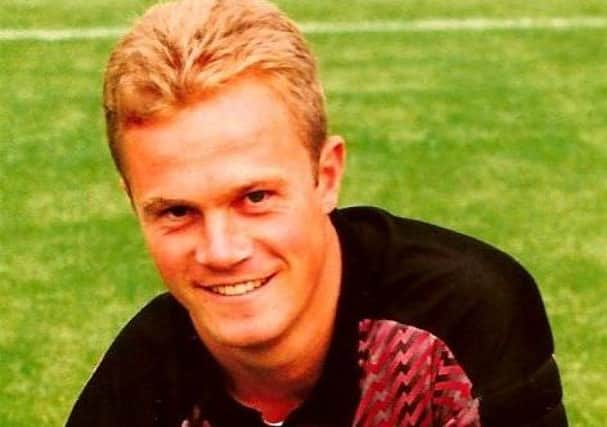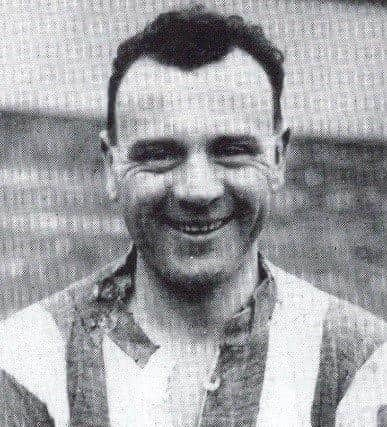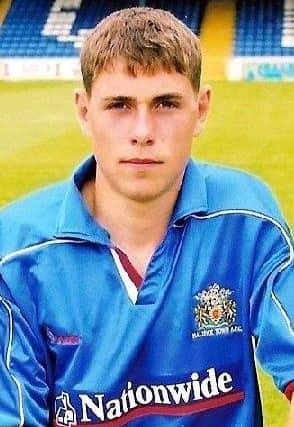Halifax Town: The ones that got away


It’s a subject that occasionally crops up on the club messageboards and in pubs (before lockdown).
When talking of former Halifax Town players, what of the ones that got way?
Advertisement
Hide AdAdvertisement
Hide AdThe players who arrived at the club, failed to impress for whatever reason, then went on to greater things with other clubs.


One player who immediately comes to mind is Scott Hogan, a striker brought to The Shay by Neil Aspin in November 2010 when FC Halifax Town were beating all before them in the Unibond Premier Division.
A former schoolboy with Everton and with failed trials at Manchester United behind him, Hogan was taken on at the Rochdale Academy whilst studying for a BTEC sports qualification at Salford City College, trying to make ends meet by working in a warehouse and chemical factory.
But having been released by Rochdale, he was left looking for a club and rocked up at Woodley Sports, where he showed signs of his potential by scoring 21 goals from just 27 appearances.
Advertisement
Hide AdAdvertisement
Hide AdThis suggested Hogan could have added competition with Halifax, hence Aspin bringing him to The Shay where his brother Liam was not only a star centre-back, but also skipper.


But with a forward line already blessed with Jamie Vardy, James Dean, Lee Gregory and Danny Holland, it was always going to be a tall order for Hogan to force himself into the reckoning, and thus he found himself playing in the minor cups – with a degree of success – but restricted to just 14 league appearances, eight of which were from off the bench, and failed to find the target in any of them.
Town, of course, had coasted towards the championship, and Hogan was still at the club when the new season began, but found himself again overlooked.
His only league appearance was as a substitute for Gregory in the goalless draw at Boston United on 29 August 2011, having returned from a four-week loan period with Mossley.
Advertisement
Hide AdAdvertisement
Hide AdHogan left the club in December 2011 and did the non-league rounds with Stocksbridge Park Steels, Ashton United and Hyde United before rejoining League Two side Rochdale, where his career took off.


He scored on his debut in a 3-0 success over Hartlepool United on the season’s opening day, bagged hat-tricks in matches against AFC Wimbledon and Oxford United, and ended up top scorer with 19 goals in all competitions.
Suddenly Hogan was hot property, and for a player who’d struggled to make an impact with FC Halifax Town, his transfer to Brentford now commanded a £750,000 fee.
But disaster was just around the corner. Sixteen minutes after coming as sub in the match at Rotherham United on his second appearance, Hogan snapped cruciate ligaments and was out of action for 19 months.
Advertisement
Hide AdAdvertisement
Hide AdBut he returned to the side in 2016-17 and began to show what he was capable of, his 14 goals in the first half of the season leading him to a £12m move to Aston Villa that January.
But things didn’t necessarily go to plan for the player, though he did contribute six goals to help Villa into the Championship play-offs two seasons ago, appearing from off the bench in the final at Wembley where Villa lost to Fulham, and won his first Republic of Ireland cap in the friendly with Turkey in March 2018.
A loan spell last season at Chris Wilder’s Sheffield United saw him notch two goals to help the Blades achieve promotion to the Premier League, and the start of the present campaign saw him loaned out to Stoke City.
At the time of lockdown, it appeared Hogan was finding his true form once more, the goal he scored in the Blues’ defeat at Reading just before the football programme was suspended was his seventh from just eight league appearances, suggesting he has much more to offer.
Advertisement
Hide AdAdvertisement
Hide AdYou could draw certain parallels with Hogan’s career to that of another striker who failed to make much of an impression during his short time at The Shay, though in the case of Grant Holt perhaps age was a contributory factor, for at the time of his arrival as a raw eighteen-year-old the club was hardly blessed with top-line strikers,
Steve Kerrigan apart. Holt had been on the books of Carlisle United but had been treading the boards with Workington in the Unibond First Division North whilst employed fitting car tyres.
He hit the headlines when he scored a hat-trick after coming on as substitute in the 6-1 win over Cheadle on 17 April 1999 but had failed to find the target during the early weeks of the 1999-00 season when Halifax Town boss Mark Lillis brought him to The Shay.
Some claimed he had the potential to be the ‘new Geoff Horsfield’ – it could be argued that in the long term they were right – but Holt’s time at The Shay was spent largely in the reserves, and he hardly impressed when he made his league debut as a sub for Kerrigan in the 2-1 defeat at Swansea City on 5 November 1999.
Advertisement
Hide AdAdvertisement
Hide AdHolt made only one start for Town that term, against Hartlepool United in the Auto Windscreen Shield, and his only goal for the club came the following eason, a header in the defeat by Tranmere Rovers in the second leg of a Worthington Cup tie played at Bradford City’s Valley Parade.
He left The Shay in January 2001, with his footballing journey taking him far and wide, playing in Australia and Hong Kong, before returning to these shores to play for Barrow, where he found his goalscoring touch.
Holt was taken on by Sheffield Wednesday in March 2003 but it wasn’t until he joined third-tier Rochdale the following January that his career took off.
Top scorer with 24 goals in all competitions in 2004-05, there was no holding him back the following season and Holt had bagged a further 14 goals when he made a £300,000 move to League One side Nottingham Forest, where, despite spending much of the 2006-07 season on the bench, he managed 18 goals for the club and was voted the supporters’ Player of the Year.
Advertisement
Hide AdAdvertisement
Hide AdA fall-out with manager Colin Calderwood saw him go out on loan at Blackpool, but he returned to the City Ground and continued to score goals before Shrewsbury Town broke their record transfer fee by signing him in July 2008.
But it is Norwich City with which Holt’s name is readily associated, and after he had netted 20 goals for the Shrews,
Canaries’ boss Bryan Gunn shelled out £400,000 to take him to Carrow Road. Gunn would be replaced within weeks of the new season by Paul Lambert, who immediately installed Holt as skipper, and the striker spearheaded the club’s drive for the League One title, top scorer with 24 goals.
Norwich went even better the following term, reaching the so-called promised land of Premier League as runners-up to Queen’s Park Rangers, with Holt showing no let-up in form by scoring 21 goals, a haul which included a never-to-be-forgotten hat-trick against local rivals Ipswich Town.
Advertisement
Hide AdAdvertisement
Hide AdHe would continue to score regularly in the top flight, and proved popular with the fans who voted him their Player of the Year three seasons in succession.
He scored his 78th goal for the club on his last appearance in the 3-2 victory over Manchester City on the final of day of the 2012-13 season then continued his footballing journey by turning out for Wigan Athletic, Huddersfield Town, Wolverhampton Wanderers and former club Rochdale, for whom he scored the last of his 154 league goals.
Subsequently, Holt was seen playing in Scotland with Hibernian, had a stint with Kings Lynn Town, but finished his playing days back at Barrow, where he moved into coaching.
He later dabbled in wrestling then returned to Norwich City to be part of their coaching staff with the Academy, whilst also developing his media work with BT Sport.
Advertisement
Hide AdAdvertisement
Hide AdBut never one to say no to a game, in January 2020 he agreed to help Thurlow Nunn Premier Division Wroxham in their bid for automatic promotion, and things were looking promising with the side lying fifth and with games in hand until lockdown.
There could be arguments put forward for two goalkeepers who got away, though in the case of one, the club actually received money for his services.
It’s what they both subsequently went on to achieve in the game which merits inclusion here. York-born Bobby Mimms joined the club as a sixteen-year-old straight from school in 1980, signed by then manager George Kirby, who must have realised his potential.
But the only time he was seen by anything resembling a large crowd was in a Shay friendly with Huddersfield Town in August 1981 and it was after impressing with the reserves in a North Midlands League match against Rotherham United that the Millers boss Emlyn Hughes shelled out £15,000 for the young keeper, who thus left The Shay without having played a single competitive first team game.
Advertisement
Hide AdAdvertisement
Hide AdAt Millmoor, Mimms became the club’s recognised first team choice midway through the 1983-84 season, and in May 1985 made a £160,000 move to an Everton side which had just been crowned League champions.
There, he would understudy the legendary Neville Southall, but it was injury to Southall in the final weeks of the 1985-86 campaign that gave Mimms his chance – he was recalled from a loan spell at Notts County – and he was fortunate to represent the Toffees in that season’s FA Cup Final, which was lost to neighbours Liverpool, and the following season’s curtain-raiser in the Charity Shield.
Competent enough to win three England Under 21 caps, Mimms nevertheless would make just 29 league appearances for Everton, and having been loaned out to several other clubs, notably Tottenham Hotspur and Aberdeen, found success at Blackburn Rovers, being part of the revolution under owner Jack Walker.
He missed only one game in 1991-92 as Rovers secured promotion to the Premier League after play-off success over Leicester City and remained first choice keeper until manager Kenny Dalglish signed Tim Flowers, thus restricted to just four league appearances in 1994-95 when Blackburn clinched the title.
Advertisement
Hide AdAdvertisement
Hide AdMimms later dropped down the leagues, enjoyed another spell with Rotherham, and retired with 471 league appearances to his name, before moving into coaching, and is currently the national goalkeeping coach with Bangladesh.
The son of the much-travelled footballer and manager Bobby Gould, Jonathan Gould’s route to goalkeeping success was somewhat unconventional.
Though born in Paddington and educated in Bristol, he spent time living in New Zealand and played for Napier City Rovers, helping them win the New Zealand National Soccer League in 1989 but not as a goalkeeper, rather as a defender.
He took to goalkeeping upon his return to England, playing for Clevedon Town, from where Halifax Town manager Jim McCalliog signed him in October 1990 due in the main to injury to David Brown.
Advertisement
Hide AdAdvertisement
Hide AdGould made a somewhat nervous league debut in an astonishing 5-3 victory over Blackpool, having been beaten twice within the first 14 minutes, but he quickly made the goalkeeping position his own, although his first season with the club was interrupted when he received facial injuries that required 24 stitches in the match with Walsall in March 1991.
He was out of action for over a month but returned to the side, though during 1991-92, he found himself relegated to the reserves following John McGrath’s signing of Lee Bracey, and having made the last of his 48 first team appearances in the 2-0 Autoglass Trophy defeat by Scunthorpe United in January 1992, Gould was released from his contract and joined father Bobby at West Bromwich Albion.
He later followed him to Coventry City, making his debut in a shock 5-1 victory over Liverpool on 19 December 1992 in what was the first season of the newly created Premier League, but he would make only 25 league appearances in four seasons at Highfield Road, and his first taste of success came when he went on loan at Bradford City in March 1996, being part of the side which clinched promotion from the Second Division via the play-offs following the 2-0 defeat of Notts County at Wembley.
Gould made the switch to Bradford City a permanent one only to lose his place in the side to Mark Schwarzer.
Advertisement
Hide AdAdvertisement
Hide AdHe went on loan to Gillingham, then in August 1997 made a surprise move to Scottish giants Celtic, then under the managership of Wim Jansen, and to the amazement of many, became one of the mainstays of the side that prevented Rangers completing ten successive championships, missing only one League game as Celtic went on to clinch the title in his first season.
And in a memorable campaign, Gould also picked up a winners’ medal as Celtic defeated Dundee United 3-0 in the final of the Scottish League Cup and his performances earned him a call-up to the Scotland national side, being a squad member at the 1998 World Cup Finals.
He earned his first full cap, qualifying through his grandparents, in a 3-0 win over Lithuania in October 1999 in a Euro 2000 qualifying match, and earned his second a year later in the 2-0 friendly defeat by Australia.
With Celtic, Gould continued as first choice keeper under both Josef Venglos and John Barnes, and picked up a second Scottish League Cup winners’ medal when Celtic defeated Aberdeen 2-0 in the final, and added a third the following season with Celtic’s 3-0 defeat of Kilmarnock, whilst also collecting a second League championship winners’ medal.
Advertisement
Hide AdAdvertisement
Hide AdIt was all a far cry from his time at The Shay. Gould eventually left the Parkhead club in January 2003, turned out for Preston North End and Hereford United, then moved into coaching, holding positions with the New Zealand national side, West Bromwich Albion, Middlesbrough, and since last August, Preston North End.
Many years later, then chairman Jim Brown would reflect on the club’s decision to let Gould go on a free as an ‘out and out disaster’.
My last offering highlights the somewhat curious career of the little known inside-forward Andy Lincoln, who played for a succession of clubs without distinguishing himself, apart from, that is, two outstanding seasons he spent with Stockport County, where he wrote himself into the club’s record books.
It was following Halifax Town’s election to the newly formed Third Division (North) in 1921 that Lincoln, hitherto a player with sides near his local Seaham Harbour home and a trialist with Midland League Lincoln City, arrived at The Shay keen to impress, and having shown ‘neat ball control’ in the practice match a week before the season’s opener at Darlington, was offered terms by the club.
Advertisement
Hide AdAdvertisement
Hide AdBut manager Joe McClelland was keen to go with Fred Dent, Syd Hetherington and Jack Woods, and as such, Lincoln was kept in the reserves until offered his chance for the visit of Stalybridge Celtic on 8 October 1921, though he failed to impress as Town slipped to a 3-2 defeat, with the forward line being described as ‘disorganised’.
Lincoln never featured again, slipped quietly out of the club, and picked up his career back in the north-east with Boldon Villa, though by 1923-24 he was playing for non-league Peterborough & Fletton United, and, indeed, was part of the side which faced Halifax Town in a first round FA Cup tie on 1 December 1923, won 1-0 by the Shaymen.
Lincoln was offered the chance of League football with Millwall in June 1924, but despite proving himself as a goalgetter – he netted a hat-trick in a 3-1 defeat of Norwich City in February 1926 – he was never able to command a regular place in the side.
Nor was his time at Northampton Town any more profitable; he made just two appearances, and there was little indication of the scoring prowess he would show with Stockport County, whom he joined in July 1929.
Advertisement
Hide AdAdvertisement
Hide AdBut there, he netted a hat-trick on his home debut in the 5-0 win over Barrow on 2 September 1929, and immediately struck up a strike partnership with Frank Newton, the pair netting 63 goals between them – Lincoln netted 27 from 42 league appearances – in his first season with the club, as County finished Division Three (North) runners-up to Port Vale.
Between 25 January and 8 March that term, Lincoln also netted in nine consecutive matches, a club record that still stands, and though he was less prolific in his second season, he still ended his time at Edgeley Park with an impressive 39 league goals to his name from 81 appearances.
He then returned to Lincoln City, scoring twice in his first game back in the 6-0 opening day defeat of Hartlepools United but making only four league appearances in a season which would see the Imps clinch the Third Division (North) title, hampered for the most part by injury.
He returned to the north-east, turned out for Gateshead, continued on his travels with Workington where he suffered a serious knee injury, and finished his playing days with a couple of Durham-based clubs.
In 1939 Lincoln was working as a contract labourer in South Shields.
Comment Guidelines
National World encourages reader discussion on our stories. User feedback, insights and back-and-forth exchanges add a rich layer of context to reporting. Please review our Community Guidelines before commenting.